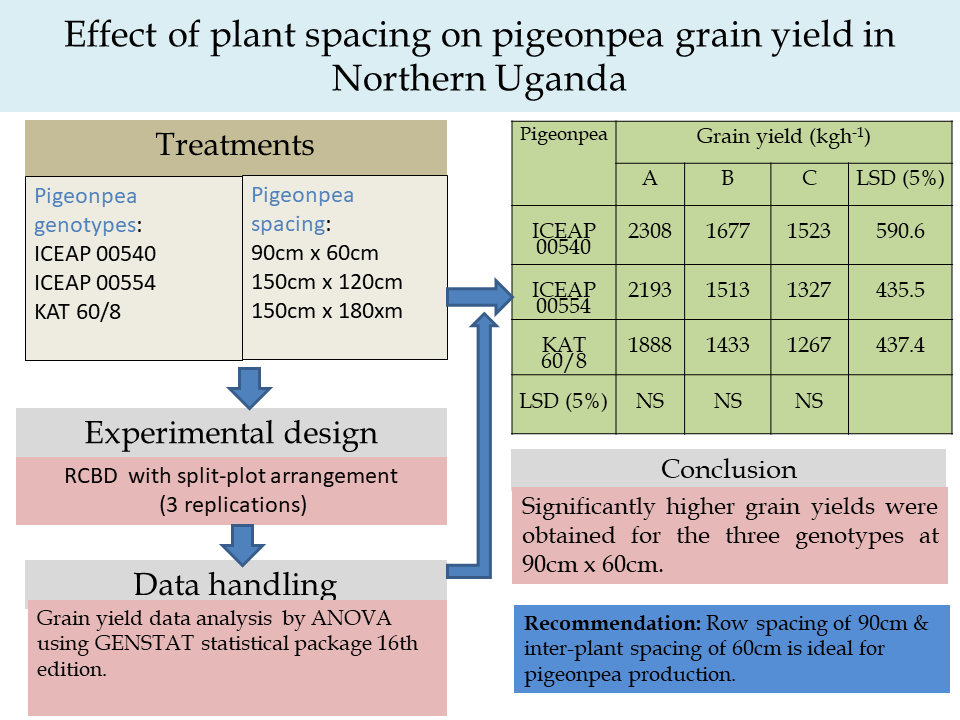Effect of plant spacing on pigeonpea grain yield in Northern Uganda
DOI:
https://doi.org/10.14295/bjs.v3i4.548Keywords:
pigeonpea, plant spacing, grain yieldAbstract
The aim of crop production is to achieve the highest possible yield per unit area. One way of increasing productivity per unit area is through plant spacing optimization. The effect of plant spacing (90 cm x 60 cm, 150 cm x 120 cm and 150 cm x 180 cm) on yield of three pigeonpea genotypes (KAT 60/8, ICEAP 00540 and ICEAP 00554) was investigated on-station in a small-plot field experiments in 2018. Significant differences were recorded in grain yield of all the three genotypes. The highest yield for all the three genotypes was recorded for row spacing of 90 cm and inter plant spacing of 60 cm, and the lowest for row spacing of 150 cm and inter plant spacing of 180 cm. Plant spacing effect on other yield parameters (number of pods per plant and 100 seed weight) were not significant. Similar effects were recorded for plant growth parameters (plant height and number of primary branches). Thus, it can be concluded that row spacing of 90 cm and interplant spacing of 60cm is appropriate for pigeonpea grain production in Uganda.
References
Behera, S. K., Shukla, A. K., Tiwari, P. K., Tripathi, A., Singh, P., Trivedi, V., Patra, A. K., & Das, S. (2020). Classification of pigeonpea (Cajanus cajan (L.) millsp.) genotypes for zinc efficiency. Plants, 9(952), 1-14. https://doi.org/10.3390/plants9080952. DOI: https://doi.org/10.3390/plants9080952
Drummond, R. S. M., Janssen, B. J., Luo, Z., Oplaat, C., Ledger, S. E., Wohlers, M. W., & Snowden, K. C. (2015). Environmental control of branching in Petunia. Plant Physiology, 168, 735-751. https://doi. org/10.1104/pp.15.00486. DOI: https://doi.org/10.1104/pp.15.00486
Fatokimi, E. P., & Tanimonure, V. A. (2021). Analysis of the current situation and future outlooks for pideon pea (Cajanus cajan) production on Oyo state, Nigeria: A Markov chain model approach. Journal of Agriculture and Food Research, 6, 100218. https://doi.org/10.1016/j.jafr.2021.100218 DOI: https://doi.org/10.1016/j.jafr.2021.100218
Heitholt, J. J., & Sassenrath-Cole, G. F. (2010). Inter-plant competition: Growth response to plant density and row spacing. In: Stewart, J. M., Oosterhuis, D. M., Heitholt., J. J., & Mauney, J. R. (Eds.), Physiology of cotton, 179-186), Springer Science. https://doi.org/10.1007/978- 90-481-3195-2. DOI: https://doi.org/10.1007/978-90-481-3195-2_17
Katayama, K., Ito, O., Adu-Gyamfi, J. J., Rao, T. P., Dacanay, E. V., & Yoneyama, T. (1999). Effects of NPK fertilizer combinations on yield and nitrogen balance in sorghum or pigeonpea on a vertisol in the semi-arid tropics. Soil Science and Plant Nutrition, 45(1), 143-150. https://doi.org/10.1080/00380768.1999.10409330 DOI: https://doi.org/10.1080/00380768.1999.10409330
Kumar, C. V. S., Naik, S. J. S., Nidhi Mohan, R. K. S., & Varshney, R. K. (2017). Botanical description of pigeon pea (Cajanus cajan (L.) Millsp.). In: Vashney, R. K., Saxena, R. K., & Jackson, S. A. (Eds.), Pigeon pea genome, Compendium of plant Genomes, 17-29, 1st, Springer Inernational Publishing. https://doi.org/10.1007/978-3-319- 63797-6. DOI: https://doi.org/10.1007/978-3-319-63797-6_3
Mekonen, T., Tolera, A., Nurfeta, A., Bradford, B., & Mekasha, A. (2022). Location and plant spacing affect biomass yield and nutritional value of pigeon pea forage. Agronomy Journal, 114, 228–247. https://doi.org/10.1002/agj2.20803. DOI: https://doi.org/10.1002/agj2.20803
Meena, B. K., Hulihalli, U. K., & Sumeriya H. K. (2015). Growth, yield attributed and yield of medium duration pigeon pea hybrid ICPH- 2671 as influenced by fertility levels and planting geometry. Legume Research, 38(6), 816-820. http://dx.doi.org/10.18805/lr.v38i6.6729 DOI: https://doi.org/10.18805/lr.v38i6.6729
Mergeai, G., Kimani, P., Mwang’ombe, A., Olubayo, F., Smith, C., Audi, P., Baudoin, J-P., & Le Roi, A. (2001). Survey of pigeonpea production systems, utilization and marketing in semi-arid lands of Kenya. Biotechnology Agronomy, Society and Environment, 5(3), 145-153. https://popups.uliege.be/1780-4507/index.php?id=14793
Mishra, S., Singh, R., Kumar, R., Kalia, A., & Panigrahy, S. R. (2017). Impact of climate change on pigeon pea. Economic Affairs, 62(3), 455-457. https://doi.org/10.5958/0976-4666.2017.00057.2. DOI: https://doi.org/10.5958/0976-4666.2017.00057.2
Namuyiga, D. B., Stellmacher, T., Borgemeister, C., & Groot, J. C. J. (2022). A typology and preferences for pigeon pea in smallholder mixed farming systems in Uganda. Agriculture, 12(8), 1186. https://doi.org/10.3390/agriculture12081186 DOI: https://doi.org/10.3390/agriculture12081186
Rachaputi, R. C., Bedane, G. M., Broad, I. J., & Deifel, K. S. (2018). Genotype, row spacing and environment interaction for productivity and grain quality of pigeonpea (Cajanus cajan) in subtropical Australia. Biosciences, Biotechnology Research Asia, 15(1), 27-38. https://doi.org/10.13005/bbra/2605 DOI: https://doi.org/10.13005/bbra/2605
Reta-Sánchez, D. G., Hernández-Dozal, B., Cueto-Wong, J. A., & Olague, J. (2010). Kenaf forage yield and quality as affected. Crop Science, 50, 744-750. https://doi.org/10.2135/cropsci2009.03.0150 DOI: https://doi.org/10.2135/cropsci2009.03.0150
Singh, D., Mathimaran, N., Boller, T., & Kahmen, A. (2020). Deeprooted pigeon pea promotes the water relations and survival of shallow-rooted finger millet during drought: Despite strong competitive interactions at ambient water availability. PLOS ONE, 15(2), 1-22. https://doi.org/10.1371/journal.pone.0228993. DOI: https://doi.org/10.1371/journal.pone.0228993
Singh, S., Thenua, O. V. S., & Chauhan, R. S. (2014). Effect of inorganic and organic manures and row spacing on growth, yield and quality of pigeon pea (Cajanus cajan L.). Progressive Research, 9, 822-825.
Swathi, Y. M., Srinivasa Reddy, M., Prabhakara Reddy, G., & Kavitha (2017). Influence of density, planting patterns and mulching on yield of drip irrigated pigeon pea [Cajanus cajan (L.) Millsp]. Indian Journal of Agricultural Research, 51(6), 611-614. http://dx.doi.org/10.18805/IJARe.A-4849 DOI: https://doi.org/10.18805/IJARe.A-4849
Worku, W., & Demisie, W. (2012). Plant density of pigeon pea in southern Ethiopia. Journal of Agronomy, 11(4), 85-93. DOI: https://doi.org/10.3923/ja.2012.85.93
Zapata, M. V., Isaza, J. G. L., Betancur, L. F. R., Lopera, S. A., & Sierra, M. M. (2017). Plant growth evaluation of Cajanus cajan (L.) Millsp., Canavalia ensiformis (L.) DC. and Cratylia argentea (Desvaux) O. Kuntze., in soils degraded by sand and gravel extraction. Acta Agronomica, 66(4), 580-587. https://doi.org/10.15446/acag.v66n4.61203. DOI: https://doi.org/10.15446/acag.v66n4.61203
Zhou, X. B., Yang, G. M., Sun, S. J., & Chen, Y. H. (2010). Plant and row spacing effects on soil water and yield of rainfed summer soybean in the northern China. Plant Soil Environment, 56(1), 1-7. https://doi. org/10.17221/73/2009-PSE. DOI: https://doi.org/10.17221/73/2009-PSE

Downloads
Published
How to Cite
Issue
Section
License
Copyright (c) 2024 Alfred Kumakech, Tonny Opio, Frank Laban Turyagyenda

This work is licensed under a Creative Commons Attribution 4.0 International License.
Authors who publish with this journal agree to the following terms:
1) Authors retain copyright and grant the journal right of first publication with the work simultaneously licensed under a Creative Commons Attribution License that allows others to share the work with an acknowledgement of the work's authorship and initial publication in this journal.
2) Authors are able to enter into separate, additional contractual arrangements for the non-exclusive distribution of the journal's published version of the work (e.g., post it to an institutional repository or publish it in a book), with an acknowledgement of its initial publication in this journal.
3) Authors are permitted and encouraged to post their work online (e.g., in institutional repositories or on their website) prior to and during the submission process, as it can lead to productive exchanges, as well as earlier and greater citation of published work.




